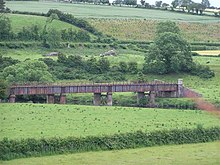54°59′38″N 7°19′34″W / 54.994°N 7.326°W / 54.994; -7.326
| Industry | railway |
|---|---|
| Founded | 1845 |
| Defunct | 1883 |
| Fate | taken over |
| Successor | Great Northern Railway (Ireland) |
| Headquarters | Derry, Ireland |
| Area served | Donegal, Fermanagh, County Londonderry, Tyrone |
The Londonderry and Enniskillen Railway (L&ER) was an Irish gauge (5 ft 3 in (1,600 mm)) railway in Ireland.
Construction and opening
United Kingdom legislation| Londonderry and Enniskillen Railway Act 1845 | |
|---|---|
| Act of Parliament | |
 Parliament of the United Kingdom Parliament of the United Kingdom | |
| Citation | 8 & 9 Vict. c. xcviii |
The Londonderry and Enniskillen Railway was incorporated by the Londonderry and Enniskillen Railway Act 1845 (8 & 9 Vict. c. xcviii). Construction began at Derry and followed the west bank of the River Foyle southwards 12 miles (19 km) to Strabane, which was reached in 1847. The L&ER's terminus in Derry was Londonderry Foyle Road station on the west bank of the River Foyle.
The line reached its summit at Fintona, County Tyrone, in 1853. Its final extension was from Fintona Junction, descending southwestwards to its terminus at Enniskillen, reached in 1854. Fintona Junction was just north of the town of Fintona, leaving the short stretch from the Junction to the town as a small branch line.
In 1859 the Dundalk and Enniskillen Railway (D&ER) reached Enniskillen, connecting the D&ER with Dundalk on the Irish Sea. Omagh became a junction in September 1861 when the Portadown, Dungannon and Omagh Junction Railway reached it from the east. The Ulster Railway worked the PD&O, giving Omagh a link with Belfast.
In 1868 the Enniskillen and Bundoran Railway opened, linking the Atlantic Coast towns of Bundoran and Ballyshannon with the L&ER at Bundoran Junction.
Operation and takeover
In 1862 the D&ER renamed itself the Irish North Western Railway (INW). In 1876 the INW merged with the Northern Railway of Ireland and the Ulster Railway to form the Great Northern Railway (GNR). The L&ER's lease continued and the company remained separate until the GNR absorbed it in 1883.
In 1857 a cow strayed onto the line near Carrigans and was hit and killed by the mail train to Omagh. Afterwards the Board of Trade Inspector criticised the condition of the track, which had been laid only a decade earlier. In 1871 there were two accidents within seven months at Mountjoy Halt, County Tyrone. Both were attributed to the poor condition of the permanent way. A level crossing across Ballyfatton Road between Strabane and Sion Mills was the scene of two accidents. In 1876 the crossing-keeper's wife was killed by a mail train and in 1883 a train hit a horse and cart, killing the horse. After the second accident the Board of Trade ordered the railway to replace the crossing with a bridge.

After takeover
Under the Great Northern the former L&ER developed in three sections. The junction with the PD&O at Omagh made the Londonderry – Omagh line part of the GNR's "Derry Road" main line with services between Belfast Great Victoria Street and Derry Foyle Road via Portadown. The Belfast and Northern Counties Railway's competing route via Coleraine was shorter, quicker and attracted more passenger traffic, but the Derry Road carried more freight. Traffic grew to the extent that by 1907 the GNR had installed double track between Foyle Road and St. Johnston, but in 1932 it was singled again.
The Omagh – Enniskillen line via Fintona Junction became a secondary route, and in 1957 the Government of Northern Ireland closed it. The short branch to Fintona became famous as the GNR worked it with a horse tram. Since the line's closure, the tram has been preserved at the Ulster Folk and Transport Museum at Cultra, County Down.
In 1958 the governments of Northern Ireland and the Republic of Ireland partitioned the GNR between them and the Derry Road became part of the Ulster Transport Authority (UTA). The line was closed in February 1965.

Footnotes
- ^ FitzGerald 1995, p. 1
- "Derry's Railways". Your Place and Mine. BBC. Archived from the original on 12 March 2010. Retrieved 24 June 2009.
- "The Evolution of Public Transport in the North West of Ireland". West Tyrone Historical Society. Archived from the original on 14 July 2011. Retrieved 24 June 2009.
- ^ Hajducki 1974, map 7
- Patterson 1962, p. 10.
- ^ Hajducki 1974, p. xiii
- Patterson 1962, p. 11.
- ^ FitzGerald 1995, p. 4
- ^ FitzGerald 1995, p. 3
- Hajducki 1974, map 3
- ^ Hajducki 1974, map 39
Sources
- FitzGerald, J.D. (1995). The Derry Road. Colourpoint Transport. Vol. 2. Gortrush: Colourpoint Press. p. 1. ISBN 1-898392-09-9.
- Hajducki, S. Maxwell (1974). A Railway Atlas of Ireland. Newton Abbot: David & Charles. ISBN 0-7153-5167-2.
- Patterson, Edward M. (1962). The County Donegal Railways. Dawlish: David & Charles. pp. 10, 11.
- Railway companies established in 1845
- Railway companies disestablished in 1883
- Irish gauge railways
- Great Northern Railway (Ireland)
- Closed railways in Northern Ireland
- Defunct railway companies of Ireland
- Transport in County Donegal
- Transport in County Fermanagh
- Transport in County Londonderry
- Transport in County Tyrone
- 1845 establishments in Ireland
- 1883 disestablishments in Ireland